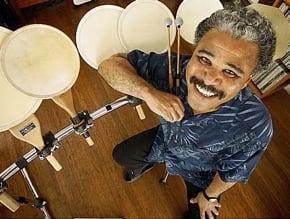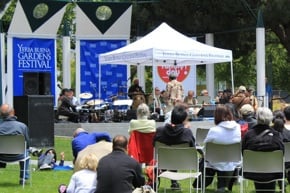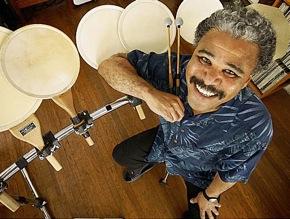
Photo by Kurt Rogers
Saturday’s furtive drizzle threatened the crowd assembled on the grassy esplanade for the fourth weekend of the Yerba Buena Gardens Festival, delaying by a quarter hour the start of the Festival’s program for that afternoon: “India and Africa: A Tribute to John Coltrane.” But when the Asian American Orchestra finally took the stage, its leader and founder, Anthony Brown, urged the waiting natives to let visitors among them know “that we’re really living in paradise.” His ensemble, it turned out, was about to offer up a gorgeous musical summons to that effort, beneath an ever-sunnier sky.
Brown, also the Orchestra’s drummer/percussionist (not to mention the son of an African-American father and a Japanese mother), went on to note that when jazz saxophonist Coltrane recorded his albums Live at the Village Vanguard, Complete Africa, and Olé Coltrane, some 40 years ago for Atlantic and Impulse! Records, he was “pioneering what we now know as world music.” The late Coltrane (affectionately called ’Trane) was also, unknowingly, providing most of the compositions and inspiration for this Yerba Buena program, for the orchestra’s 2010 release on Water Baby records (which bears the same title as the program), as well as for Brown’s contributions to a study published last year by Oxford University Press, titled John Coltrane and Black America’s Quest for Freedom: Spirituality and the Music.

Photo by Jeff Kaliss
The burble of the nearby Martin Luther King Jr. memorial waterfall, carried to audience ears on a forceful breeze that also riffled the sheet music, accompanied the intro to Coltrane’s Living Space, which Mark Izu performed on a sheng (a sort of Chinese megaharmonica). Alto saxophone and flute eventually joined in this unmetered section, the first of a suite, and African percussion led the way to India, with Steve Oda soloing on sarod, underscored by his wife Pushpa’s drone on tambura. Aside from some chording on Frank Martin’s electric keyboard, this section resembled the introductory alap section of North Indian classical raga, as did the transition to the metered accompaniment of tabla, played by Dana Pandey, a student of the renowned Zakir Hussain.
Coltrane himself never made such prominent use of Indian instrumentation, and his trademark sound grew more evident in the Olé section of the suite, with Brown (who’d been conducting) deploying his drum set, under the first of several bright and brassy sessions of assorted saxes and trumpet. The sarod didn’t quite fit into an improvisational jam with the horns, but was paired more successfully with tabla. Pandey’s joyful pyrotechnic approach to her instrument allowed her to transition the tabla from raga to flamenco mode. In the suite’s reprise of India, Prasant Radhakrishnan blew ecstatic sax, while Martin’s altered jazz chords on keyboard helped evoke, most clearly, the sonority of pianist McCoy Tyner and the rest of Coltrane’s “classic” quartet from the early 1960s.
Interplay of Art, Mother Nature, and the Kids
The Indian trio having left the stage for positions among the appreciative audience, the afternoon’s second set opened with Coltrane’s After the Rain, a reminder of the composer’s loveliness of melodic line and harmony, which was somewhat eclipsed in popular consciousness by the emotional avant-garde approach of his later recordings. This tune was arranged by Marcia Miget and graced by her soulful solo on flute, handsomely partnered by soprano saxophonist Melecio Magdaluyo and tenor Radhakrishnan.
There followed another suite, initiated theatrically by Kenneth Nash’s solo on congas, with a brief incantation in English and an African dialect, plus an amusing quote from the pop standard I’ll Remember April. As if summoned by the percussion, kids peeked through the hangings at the back of the stage and then moved on to a Matisse-like dance, holding hands under nearby trees.
Coltrane’s Africa segued into Liberia and Dahomey Dance, with Izu taking his bass on a solo exploration of pentatonic territory, common to both Africa and Asia. Brown’s own impressive solo on drums led to a particularly friendly and intimate exchange with percussionist Nash. The cohesive communication within the orchestra was further evidenced both by tasteful solo flights and by sharing among the horns, with trombonist Wayne Wallace pumping pneumatic happiness into the encore, his arrangement of Mongo Santamaria’s Afro-Blue, a favorite of Coltrane’s.
Preston Justice of the Yerba Buena staff got to speak for the sentiment shining around the esplanade at the concert’s conclusion. “This music is really nourishing to the soul,” he proclaimed into the mic, “and I’m sure, wherever John Coltrane is, he’s smiling.”

